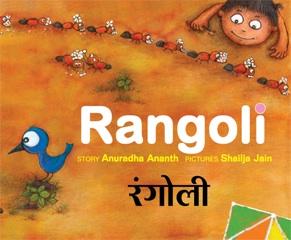
The tradition of rangolis; termed alpana, kolam, muggu, depending in which part of the country it is found in, is an ancient Indian one. One that has been passed down from generation to generation. Besides enhancing the visual appeal of one’s home, like most traditions, its roots are steeped in philosophy.
Traditionally made with powdered rice and sugar, the patterns are usually laid out within a grid of dots. The designs with either geomeric patterns or images of flowers range from the simple to the elaborate and is believed to help one earn merit or punya, by providing food for birds, insects and the other lives that thrived in the soil.
However, with rapid urbanization this tradition is fast disappearing and so a book like this is invaluable in not only informing a child about the why and the how, but also hopefully to inspire a child to keep this colourful and artistic tradition alive.
In this slim bi-lingual book, a city child visiting her grandmother, is excited to see the beautiful designs being laid out if front of all the homes in the village. Even as she is appreciative of the designs and colour, she learns the spirit of sharing and caring for tiny creatures. However when she realises that it might not be possible for her to follow this tradition in her appartment in the city, she is sad, but the ever-resourceful grandmother comes up with a happy solution.
Delightful illustrations, with a lot of interesting details, and also the instructions in the back page on creating a simple rangoli, add to the appeal of the book.
This book is available in English-Bengali, English-Tamil, English-Telugu, English-Kannada, English-Marathi, English-Hindi, English-Gujarati versions